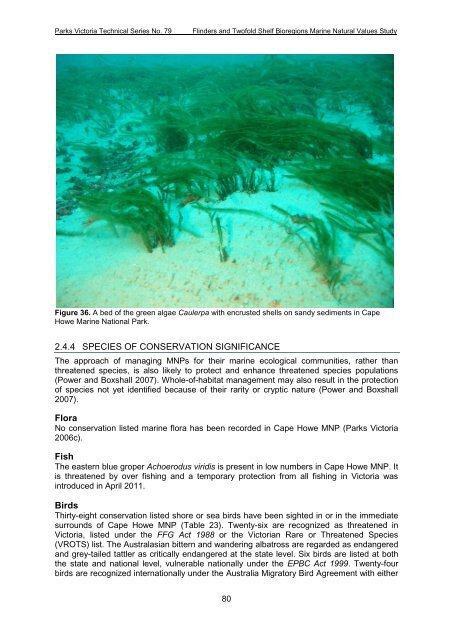parks victoria technical series marine natural values study vol 2 ...
parks victoria technical series marine natural values study vol 2 ...
parks victoria technical series marine natural values study vol 2 ...
You also want an ePaper? Increase the reach of your titles
YUMPU automatically turns print PDFs into web optimized ePapers that Google loves.
Parks Victoria Technical Series No. 79<br />
Flinders and Twofold Shelf Bioregions Marine Natural Values Study<br />
Figure 36. A bed of the green algae Caulerpa with encrusted shells on sandy sediments in Cape<br />
Howe Marine National Park.<br />
2.4.4 SPECIES OF CONSERVATION SIGNIFICANCE<br />
The approach of managing MNPs for their <strong>marine</strong> ecological communities, rather than<br />
threatened species, is also likely to protect and enhance threatened species populations<br />
(Power and Boxshall 2007). Whole-of-habitat management may also result in the protection<br />
of species not yet identified because of their rarity or cryptic nature (Power and Boxshall<br />
2007).<br />
Flora<br />
No conservation listed <strong>marine</strong> flora has been recorded in Cape Howe MNP (Parks Victoria<br />
2006c).<br />
Fish<br />
The eastern blue groper Achoerodus viridis is present in low numbers in Cape Howe MNP. It<br />
is threatened by over fishing and a temporary protection from all fishing in Victoria was<br />
introduced in April 2011.<br />
Birds<br />
Thirty-eight conservation listed shore or sea birds have been sighted in or in the immediate<br />
surrounds of Cape Howe MNP (Table 23). Twenty-six are recognized as threatened in<br />
Victoria, listed under the FFG Act 1988 or the Victorian Rare or Threatened Species<br />
(VROTS) list. The Australasian bittern and wandering albatross are regarded as endangered<br />
and grey-tailed tattler as critically endangered at the state level. Six birds are listed at both<br />
the state and national level, vulnerable nationally under the EPBC Act 1999. Twenty-four<br />
birds are recognized internationally under the Australia Migratory Bird Agreement with either<br />
80

















